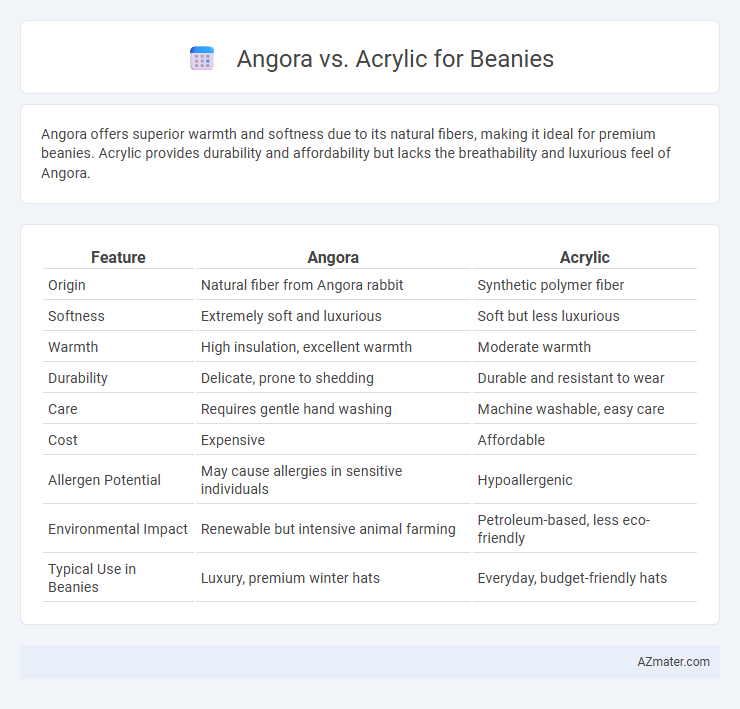Angora offers superior warmth and softness due to its natural fibers, making it ideal for premium beanies. Acrylic provides durability and affordability but lacks the breathability and luxurious feel of Angora.
Table of Comparison
| Feature | Angora | Acrylic |
|---|---|---|
| Origin | Natural fiber from Angora rabbit | Synthetic polymer fiber |
| Softness | Extremely soft and luxurious | Soft but less luxurious |
| Warmth | High insulation, excellent warmth | Moderate warmth |
| Durability | Delicate, prone to shedding | Durable and resistant to wear |
| Care | Requires gentle hand washing | Machine washable, easy care |
| Cost | Expensive | Affordable |
| Allergen Potential | May cause allergies in sensitive individuals | Hypoallergenic |
| Environmental Impact | Renewable but intensive animal farming | Petroleum-based, less eco-friendly |
| Typical Use in Beanies | Luxury, premium winter hats | Everyday, budget-friendly hats |
Introduction to Angora and Acrylic Beanies
Angora beanies are crafted from the soft, luxurious fur of Angora rabbits, offering exceptional warmth and a silky texture ideal for cold weather. Acrylic beanies, made from synthetic fibers, provide durability, affordability, and easy care, making them popular for everyday wear. Both materials cater to different needs, with Angora excelling in insulation and breathability, while acrylic ensures resilience and low maintenance.
What is Angora? Key Features and Benefits
Angora is a luxurious natural fiber obtained from the Angora rabbit, prized for its exceptional softness, lightweight warmth, and silky texture. Its fine fibers provide superior insulation by trapping heat effectively while remaining breathable, making it ideal for cozy beanies. Angora fibers are also hypoallergenic, moisture-wicking, and durable, offering long-lasting comfort and a premium feel compared to synthetic alternatives like acrylic.
What is Acrylic? Key Features and Benefits
Acrylic is a synthetic fiber made from polyacrylonitrile, widely used in beanies for its lightweight and durable qualities. Key features include excellent moisture-wicking, resistance to wrinkles and moths, and the ability to retain vibrant colors even after multiple washes. Benefits of acrylic beanies encompass affordability, easy care, and hypoallergenic properties, making them a popular alternative to natural fibers like angora.
Softness and Comfort Compared: Angora vs Acrylic
Angora beanies offer exceptional softness and luxurious comfort due to their fine, silky fibers derived from Angora rabbits, making them highly breathable and gentle against sensitive skin. Acrylic beanies, while more durable and budget-friendly, tend to be less soft and may cause itching or discomfort during extended wear. For optimal softness and comfort, Angora beanies surpass acrylic options, providing a cozy, lightweight feel ideal for cold weather.
Warmth and Insulation: Which Beanie Reigns Supreme?
Angora beanies offer superior warmth and insulation due to their natural hollow fibers, which trap heat effectively and provide lightweight softness. Acrylic beanies, while less warm, maintain insulation even when wet and are often more durable and affordable. For maximum warmth in cold climates, angora beanies reign supreme, especially in retaining body heat without bulk.
Durability and Maintenance: Angora vs Acrylic
Angora beanies offer natural softness but require delicate care, as their fibers are prone to matting and shrinkage, making hand washing or dry cleaning essential to maintain durability. Acrylic beanies provide higher durability with strong, synthetic fibers that resist wear, stretching, and frequent machine washing without losing shape or integrity. Choosing between Angora and Acrylic depends on balancing the luxury of softness with the ease of maintenance and long-term resilience.
Allergen and Sensitivity Factors
Angora fibers are derived from Angora rabbits, known for their softness but also potential to cause allergic reactions due to animal proteins and lanolin content. Acrylic yarn, a synthetic fiber, is hypoallergenic and less likely to trigger sensitivities, making it a safer choice for individuals prone to wool or animal fiber allergies. Choosing acrylic over Angora reduces risks of skin irritation and respiratory allergies commonly associated with natural animal fibers in beanie materials.
Cost and Affordability Differences
Angora beanies typically cost significantly more than acrylic ones due to the expensive, labor-intensive harvesting of angora rabbit fibers, resulting in a luxury product with natural softness and warmth. Acrylic beanies are much more affordable, as synthetic fibers are cheaper to produce and widely available, making them ideal for budget-conscious consumers. The cost difference often reflects the durability and insulation properties, with angora providing superior quality but acrylic offering accessible price points.
Eco-Friendliness and Ethical Considerations
Angora, sourced from Angora rabbits, offers superior biodegradability and renewable fiber benefits, making it more eco-friendly compared to acrylic, a synthetic polymer derived from fossil fuels with significant environmental footprint from production to disposal. Ethical concerns arise with Angora, as traditional harvesting methods can cause animal distress, prompting the demand for cruelty-free and certified ethical sourcing. Acrylic lacks animal welfare issues but poses sustainability challenges due to microplastic pollution and non-biodegradability, influencing eco-conscious choices in beanie materials.
Choosing the Right Material for Your Beanie
Angora fibers offer exceptional softness, warmth, and natural insulation, making them ideal for premium beanies designed for cold climates, while acrylic yarn provides durability, affordability, and ease of care, perfect for everyday wear and budget-conscious buyers. Consider angora for a luxurious, breathable hat that resists moisture and retains heat, whereas acrylic suits those seeking colorfast options and hypoallergenic properties without the risk of animal fibers. Evaluating factors such as warmth retention, maintenance requirements, and price point helps determine whether angora or acrylic is the best fit for your specific beanie needs.

Infographic: Angora vs Acrylic for Beanie
 azmater.com
azmater.com